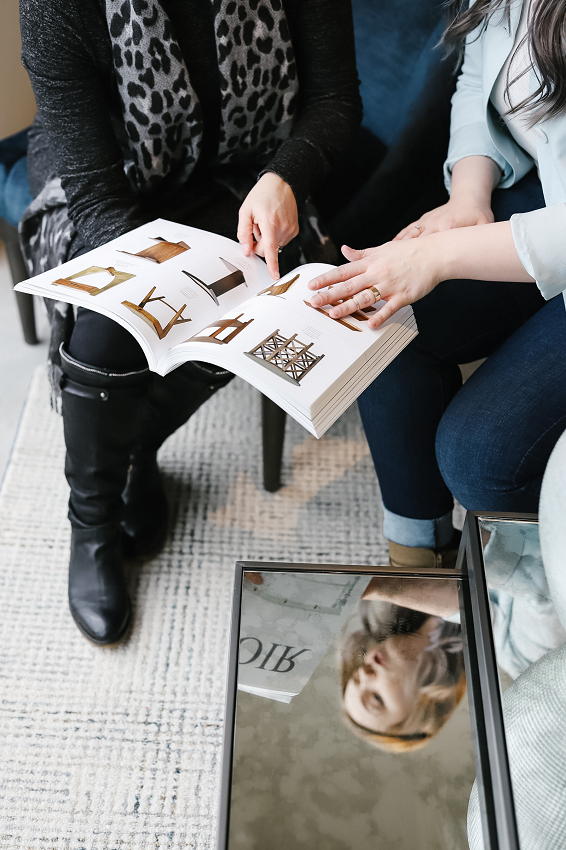
Can you guess one of the single most common misconceptions among people considering an interior design project? I’ll give you a hint…it has to do with money. If you guessed “they expect what they want to spend is going to cover their wish list” then you are right!
I can honestly say that 100% of the time, the number a client has in their head will not cover what is on their wish list.
Read on as I share how we help our clients build a realistic budget so they know what to expect before they dive into their project…

What is an Interior Design Budget?
First, let’s clarify what we mean by “budget.” We define the project budget as the actual cost for the goods and services required to complete your project.
Given this definition, the project budget cannot be finalized until after the design phase, when plans have been drawn up, finishes have been selected, and decisions have been made. It is then, and only then, that you have all the information to determine what your project will cost. For us, this is at the end of Step 5: The Presentation.
If you tell us up front that your project “budget” is $100,000, you are referring to the number that you are comfortable investing in the project or an amount that you have set aside or can borrow, not necessarily how much it will actually cost to complete your wish list.
This is an important distinction to make. We can only complete a project successfully with a budget that is realistic and, because you have not likely done this exact renovation before, you usually need our help determining what is realistic.

What Impacts Your Interior Design Budget?
There are many factors that affect a project’s budget. These may include:
- The scope of work
- Your short- or long-term plans for the property
- The quality of the finishes you select
- The market value of the other homes in your area vs. what you paid for the home
- The value of the upgrades to you and your family
If you expect to be in your home for less than 3 years, your focus may be on selecting value-priced finishes so you can recover your investment when you sell. You will also want to consider the value of your home compared to others in your area.
If you are working on your “forever” home, we encourage you to invest in materials and finishes that are high quality and will stand the test of time. You may have to stretch your investment or tackle your project in stages to get what you want; either way, it will be worth it to you and your family in the long run.

How Does Simply Home Decorating Help You Create Your Project’s Budget?
We begin the conversation about budget during our discovery call. Most people say that they have no idea what a project like theirs might cost, however, in our experience, clients typically have a number in their head that represents what they are comfortable spending.
During the initial call, we may provide some general information about a realistic budget for a project of a similar scope but, having not seen the project, it is much too early to determine what is realistic.
That is why an important part of our process during your 2-hour design discovery session is to determine a project scope and make a detailed list of all the goods and services required to complete your project.
When we prepare your design proposal, we assign a price range to these goods and services. This is what we call a “preliminary working budget.” When you see what the required spend could be for your wish list, we can determine a reasonable project scope for the design phase because, obviously, you won’t want to hire us to do design work that you can’t afford to execute.
Once we proceed to the design phase, we keep your budget comfort level in mind, however our strategy is to price out our clients’ wish list and present that to you at Step 5: The Presentation. Then, if needed, we will dial back from there during your Budget Review (Step 6).
For more information about our design process, read here.

How Can You Prepare for Our Budget Conversation?
Create a Wishlist & Prioritize
The first step, which is part of every new client’s “homework”, is to make a detailed list of everything that you would like to do if budget was not an issue and then consider your priorities.
If your wish list exceeds your budget and you decide to complete your project in stages, it is helpful to know what areas you will tackle first. Will it be the living room where you entertain, the family room where you and your kids spend the most time, or the master bedroom that only you will see but that contributes to a more restful night’s sleep?
Keep in mind that when it comes to renovations there is a natural order to the work being done. You would not want to put in new kitchen cabinets and then decide to change the tile floors. As professionals we can advise you about what items should naturally be completed first.
Get Decision-Makers on the Same Page
It is critical that everyone is on the same page about what takes priority. Your husband might want a man cave and you might want an organized walk-in closet. If your investment will not allow for both, please discuss in advance which project will win out.
Although we can provide our professional opinion about what should come first from a workflow perspective, we are not qualified marriage counsellors!

Don’t Forget about Value
During the design phase we are focused on making selections that fall within what we have determined is a “reasonable budget” for your project.
Sometimes that means a careful mix of high and low-cost goods. When budget considerations are an issue, we encourage you to spend more on high touch, heavy use items like the family room sofa or on things that have high visual impact and make the room special, like a piece of original art. Rest assured that when we are sourcing for your space, budget is always top of mind.
Stay Open to Creativity
One of our roles as your designer may be to come up with creative solutions that work for your space within a reasonable budget. While we are focused on bringing your wish list to life, this might not always take the form that you are expecting.
If you have an open mind, we can help you think “outside the box” to get the functionality that you need for less.
Let’s say you were thinking about finishing your basement to include a new home office space, but we discover that a basement renovation will cost more than you are comfortable spending. You still need that home office so we will look for space in the finished rooms of your house that could accommodate that need – like a guest room closet that can be converted with a built-in desk and some storage. It might not be what you were thinking but it just might work.

Let’s face it, in most design projects you will end up spending more than you initially wanted to spend, so we want to help make sure that the results you get are truly worth the stretch.
Just remember, in two years’ time you won’t miss the $1,200 you spent installing in-floor heating in your ensuite, but you will relish the sensation of nice warm feet when you step out of the shower every morning.
Wondering what it will take to start your own design project? We’d love to chat with you about it!
Until next time,
Lori











